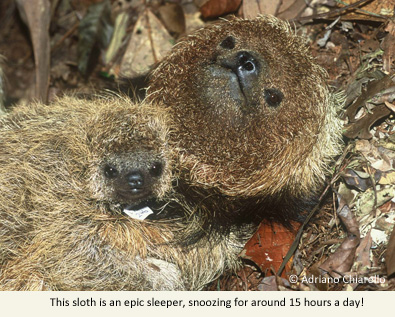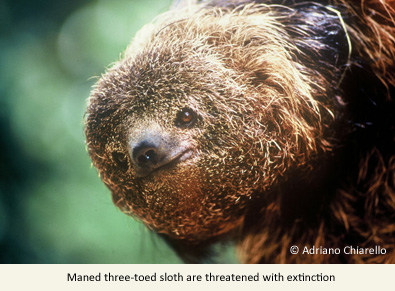It was the pygmy three-toed sloth last week, now we’re continuing with the sloth theme this week with the maned three-toed sloth (although it has been species of the week already, we think they deserve some more press!).

What differs the maned three-toed sloth from the others is its distinctive long black ‘mane’, which sits like a collar on its neck and shoulders.
Like the pygmy sloth, the maned sloth loves to be high up in the canopy, clinging to trees, and unless they need to go to the toilet the sloths spend most of their life up among the branches. Maned sloths have fur that grows in the opposite direction to that of most mammals, with a dusting of algae that is thought to protect them from predation through disguise in their green habitat.

Sloths are very slow in nature: their average body temperature is kept low to save energy and their metabolic rate is about half of that of most mammals, so they must sleep for around 15 hours a day.
The maned sloth is only found in the Atlantic coastal rainforest of Brazil, which continues to be disturbed and fragmented as a result of logging, charcoal production, and clearance for plantations and cattle pasture. Occasionally maned sloths have been victims of poaching, as locals use them for a source of bushmeat. 
The large gaps in the forest mean that some populations may already be extremely small, but there are no reliable estimates about the actual number of individuals left in the wild. Maned three-toed sloths were downgraded from Endangered to Vulnerable by the IUCN in 2011, but the Mata Atlântica region in which the species lives has the highest human population in Brazil which will probably continue to grow and as a result will put more pressure on the flora and fauna of the area.

Right now EDGE is running a campaign to help save the maned three-toed sloth’s close relative, the pygmy three-toed sloth, of which there are less than 100 left on the tiny island of Escudo.
We need you to play a part in securing the future of these amazing and unique animals through helping us fund educational and outreach programmes for the local communities, with the aim to ultimately stop poaching and habitat destruction.
Do it for the sloths!